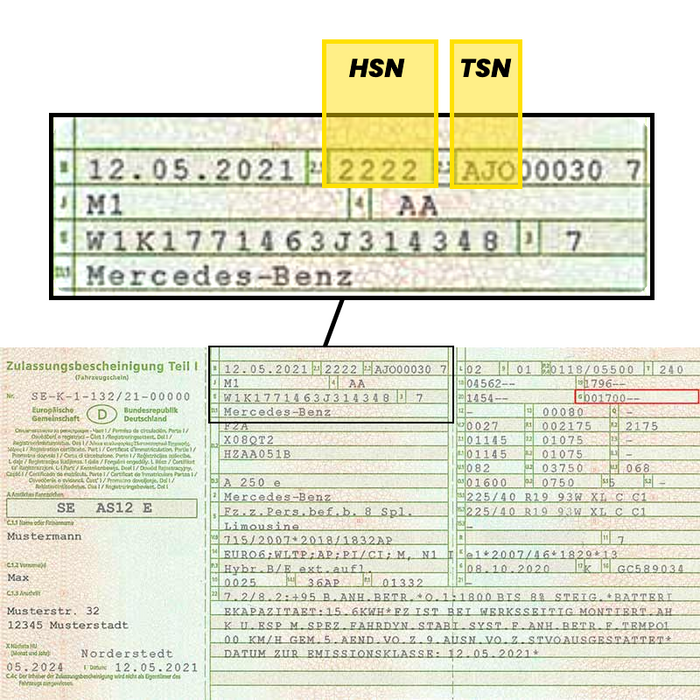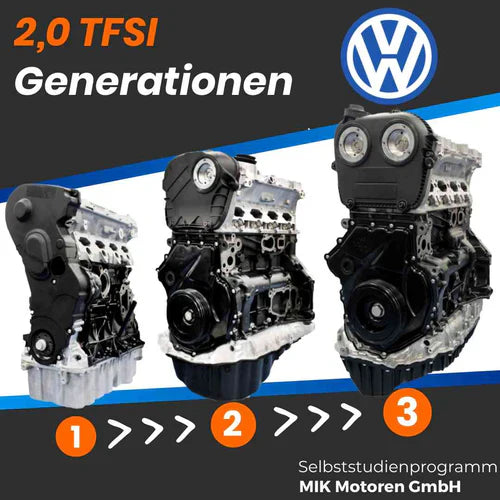TSI or TFSI?
In the world of turbo gasoline direct injection, the TSI or also TFSI Motor is a central component of many models of the VAG group, which includes VW, Audi, Seat, and Skoda. The different generations of this engine each offer their own advantages and pitfalls. Here is a more detailed look at the characteristics and development of this engine.
First, it should be clarified that the designations TSI and TFSI The manufacturers can use them arbitrarily. Both the TSI engine and the TFSI are based on a turbocharged direct injection concept. For example, the EA888 engine can be found in Audi under the designation TFSI and in Skoda or VW under the designation TSI. Originally, the abbreviations were based on a technically different meaning.

EA113 - The first TFSI
The first generation of the TFSI engine (EA113), a product of the innovative engineering of the VAG group, marked an era of turbo engines in the automotive industry. Introduced in popular models such as the Golf 5 and Golf 6, from racing cars in various series, the engine combined power with efficiency and thus helped turbo direct injection gain great popularity. Despite the initial enthusiasm, however, vehicle owners soon faced some problems that called the reliability of the EA113 engine into question.
A key distinguishing feature of the first generation was the timing belt drive. This design was the norm at the time, although later generations switched to a chain drive. The timing belt played an important role in synchronizing the engine control and works absolutely reliably with good maintenance.

A frequently discussed problem was the balance shaft module, associated with the oil pump. The module itself is crucial for the smooth operation of the engine and efficient oil circulation. Design flaws and wear in this area lead to inefficient operation of the Oil pump, which in turn means a drop in oil pressure and severely affects the lubrication of the engine. Oil pressure warning messages up to engine damage are the result of a defective balance shaft module. Today we replace this with an upgraded oil pump, thereby significantly extending the longevity of the 2.0 TFSI Gen1 engine.
The camshaft adjusters were also a weak point of the first 2.0 TFSI engine generation. These components are responsible for adjusting the camshafts and thus for the timing of the valve actuation. Malfunctions due to insufficient oil pressure could lead to error messages and consequently to suboptimal engine performance. A precise Oil pressure It is essential for the correct functioning of the camshaft adjusters, and difficulties in this system can lead to a chain of errors of both mechanical and electrical nature.
Particularly noteworthy are the various designs of the connecting rods, which support different performance levels depending on the needs. Standard connecting rods were designed for everyday loads, while reinforced variants (CDL, BYD) were developed for high-performance applications of up to 300 HP. This information is especially of interest to enthusiasts who are looking to increase the performance of their vehicle. It is important to note that with increasing engine power and mileage, the risk of ring land fractures on the piston also grows, which in turn can lead to a loss of compression and ultimately to engine problems.
For the maintenance and optimization of the first generation 2.0 TFSI, expert knowledge is required Maintenance Essential. The recognition of potential vulnerabilities enables owners to act proactively and carry out necessary updates. Despite its challenges, the engine remains a popular choice for many drivers who appreciate the combination of performance and efficiency that this engine offers.
In summary, the 2.0 TFSI of the first generation was an important milestone in the development of VW, Audi, Seat, and Skoda. Its innovative direct injection technology demonstrates the dynamics of the automotive sector and the continuous development to meet the needs of the environment. With the right knowledge and regular maintenance, this engine can continue to be a loyal companion on the roads.
EA888 - efficient, susceptible
The second generation of the TFSI engine (EA888) from Volkswagen marks a remarkable advancement in automotive technology compared to its predecessor, the EA113. The new design aimed to balance efficiency and performance but faced some long-term challenges that affected reliability.
The most noticeable difference of the EA888 compared to its predecessor was the use of a Timing chain Instead of a timing belt. The timing chain was considered maintenance-friendly and durable, but it became a cause for concern as it was prone to premature wear and damage. Despite the initial hope that the chain would increase reliability and reduce maintenance costs, it turned out to be the Achilles' heel of the engine.

The performance of the EA888 has been limited to a maximum of 211 hp, which was likely a deliberate decision to ensure the Efficiency To maximize. Interestingly, this engine was never designed to achieve high performance in production vehicles. This suggests that efficiency was prioritized over performance in the design.
A further characteristic feature of the EA888 is the fully adjustable Oil pumpThis was introduced to optimize the oil pressure and to pump only as much oil as the engine needed for lubrication at a given time. However, with increasing mileage and the natural wear of the components, the oil pressure could fall below a critical level, which could then lead to damage to the camshafts, camshaft adjusters, and the timing chain.
The EA888 engine features a sophisticated timing chain system with three chains that drive the camshafts, the oil pump, and two balance shafts. These balance shafts, which are now located in the engine block instead of the oil pan, have been equipped with fine chains to minimize running resistance. However, this delicate construction has led to an increased susceptibility to chain damage and, in the worst case, total failures due to broken chains.
The most well-known problem of the EA888, however, are the pistons and the Piston rings. They are designed for maximum efficiency and are therefore very delicate and slim in construction. In particular, the oil scraper ring, which is only 1.5 mm wide, was unable to effectively scrape off the oil adhering to the cylinder walls, leading to oil consumption and combustion. The oil carbon generated during the combustion of the oil could enter the oil circuit and clog the return holes of the piston rings, further exacerbating the problem of oil consumption.
An oil consumption of up to one liter per 1000 kilometers was not uncommon with these engines. This high oil burning rate often led to piston and valve damage due to the high combustion temperature of the oil, resulting in serious engine damage.
When overhauling TFSI engines, it is of utmost importance that all known weaknesses are addressed with the right upgrades. This includes replacing the timing chain, oil pump, and piston rings with reinforced, high-quality components. Otherwise, even a costly overhauled engine will remain an efficient but potentially risky machine. Without these essential improvements, the EA888 can become a ticking time bomb despite all its efficiency, potentially leading to another engine failure at any time.
The most noticeable difference of the EA888 compared to its TFSI predecessor was the use of a timing chain instead of a timing belt. The timing chain was considered maintenance-friendly and durable, but it became a cause for concern as it was prone to premature wear and damage. Despite the initial hope that the chain would increase reliability and reduce maintenance costs, it turned out to be the Achilles' heel of the engine.
EA888 - efficient, susceptible
The evolution of the TFSI engine in its third generation, which continues to represent the EA888 development series, clearly demonstrates how far Volkswagen's engineering has progressed in optimizing performance and efficiency. While this latest model retains the core architecture of its predecessor, it comes with numerous refined changes that strengthen its position as the centerpiece of many models in the VW Group.
One of the significant improvements is the revised exhaust channel design, combined with a direct flange connection of the turbocharger – both factors that noticeably enhance the responsiveness of the TFSI engine and ensure a more direct implementation of the driver's intentions. The revised timing chain drive and the newly designed pistons are further characteristic features of this generation, indicating that VW has optimized every detail of the engine for performance and longevity.

Interestingly, the third generation TFSI was additionally equipped with a variable valve timing on the exhaust side, in addition to the intake camshaft adjustment. This allows for even finer tuning of the timing, which is particularly crucial for a turbo direct injection engine (TFSI). However, the camshaft adjustment often represents a weak point, as it is prone to defects due to low oil pressure and can only be replaced in conjunction with the camshaft.
The good news: VW has managed to get a handle on the well-known oil consumption problem of its predecessors. However, it is less encouraging that despite the increased performance potential, which exceeds 300 hp, the risk of piston damage in the TFSI still exists. These damages are particularly serious as they can direct the combustion pressure into the crankcase, leading to a loss of power and, in extreme cases, to the breakage of the oil pan made of plastic.
The oil pump technology of the engine remains unchanged, which means the problem of insufficient oil pressure, especially at idle, persists. Therefore, it is recommended to use an upgraded oil pump for this engine version as well, to increase the oil pressure and thus significantly extend the lifetime of the engine.
Another, albeit less common problem is the use of motorsport clutches, which can occasionally lead to a total engine failure due to damage to the axial bearings of the crankshaft. The wide variety of TFSI engines, which is manifested in around 40 different identification letters, makes it clear that caution is required during modifications and a careful check of the fit is necessary.
Therefore, experts advise against relying on a replacement engine in the event of damage. The high variance makes it difficult to produce a suitable replacement engine. In contrast, an engine overhaul usually also identifies and resolves the cause of the damage, which would not be the case with a simple engine swap. A new engine would quickly suffer the same damage again without addressing the underlying cause.
In summary, it is evident that an update of the oil pump and a careful overhaul of the engine – instead of a mere replacement – are crucial to ensure the reliability of the EA888 engine of the third generation. Only in this way can it be guaranteed that the performance of this engine exists not only on paper but also proves itself in everyday operation, allowing drivers to benefit from the innovative technology for a long time.
In the best hands
1.) Planning & Projecting
Before we begin the TFSI engine overhaul, we create a customized offer tailored to the specific needs of each customer. After the customer confirms the offer, we issue a detailed invoice and schedule the order in our comprehensive project management system. This system allows us to accurately track and manage both the complete documentation of the overhaul work and the shipping status of the engine.

2.) Pickup of the basic engine
We reliably organize the fast and secure shipping of the TFSI base engine through one of our in-house freight forwarders. Normally, the customer or the customer's workshop is responsible for the disassembly and storage of the components and aggregates, but they can also delegate this task to us upon request. Once the engine has been securely fastened to a pallet and is prepared for transport, we will ensure, in coordination with an appointment, for a quick and safe start of the engine overhaul.

3.) Dismantling of the base motor
Upon arrival in our workshop, an employee takes over the complete disassembly of the TFSI engine. During this first step of the engine overhaul, damages are recorded in our LIVE documentation. The professional and transparent recording of all damages is essential for a successful repair. Damage causes are defined and communicated to the customer or the customer's workshop. This ensures that the root cause of the problem is addressed and that damages do not occur again in the future.

4.) The engine overhaul
The actual engine overhaul is managed by only one employee, who is supported by an internal knowledge database. This approach guarantees high quality standards and minimizes the possibility of errors. Only for inspection and special tasks do we rely on the four-eyes principle to ensure maximum quality. All steps of the overhaul are carefully documented and are available to our customers in real-time, so they are always informed about the progress and have full transparency over the process.

5.) Removal & Installation in our house
We prefer to carry out both the engine overhaul and the removal and installation of the TFSI engine in-house. This allows us to demonstrate our entire expertise. Equipped with a dynamometer, extensive testing and diagnostic technology, as well as qualified staff, we manage your engine overhaul from start to finish. Organizing vehicle transport should not be an obstacle, as we also offer solutions for this to make the process as easy as possible for you.

4.) Support until the end
Should you choose to have the TFSI engine shipped for installation in your own workshop, we will of course provide you with comprehensive support in the implementation. We deliver detailed excerpts and instructions from our knowledge database that will assist you with the installation, commissioning, and fine-tuning of the engine. Additionally, our team is ready to respond quickly and competently to any questions or challenges during the installation or tuning of the engine.

ADDITIONAL KNOWLEDGE DOCUMENTS
Discussion 😍 😮 😇😫 😤😉
We invite you to share your experiences with us and to present, discuss, and make the OM642 a significantly better engine.
The longevity of your engine is our mission!
Suggestions for additional articles and self-study are very welcome!








